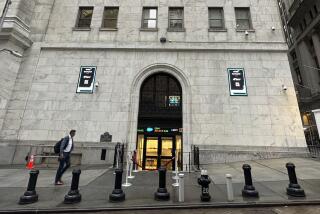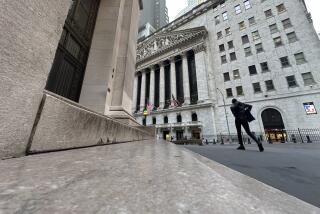Stock Indexes Surge in Fresh Wave of Buying
- Share via
Stocks zoomed again Monday, lifting major indexes to 31-month highs, as last week’s modest bout of profit taking gave way to a fresh wave of buying.
The market’s continuing rally is enriching investors and helping to support the economy’s rebound. But it’s also frustrating many people who have been waiting for a significant pullback to jump in -- and the pullback just doesn’t come.
The Dow Jones industrial average, which dipped a mere 0.3% last week after eight consecutive weekly gains, on Monday surged 134.22 points, or 1.3%, to 10,702.51, the highest closing mark since June 2001.
It was the first time the Dow had finished above its level of just before the Sept. 11, 2001, terrorist attacks.
Other key indexes, including the technology-heavy Nasdaq composite, already had topped pre-Sept. 11 levels. Nasdaq rose 29.96 points, or 1.4%, to 2,153.83 on Monday, also a 31-month high. It fell 0.8% last week after six straight weeks of gains.
Share prices were flat for the first few hours of trading Monday as would-be buyers waited to see whether last week’s decline would continue, analysts said. When selling failed to swell, sidelined investors moved in, said Art Hogan, chief market analyst at brokerage Jefferies & Co. in Boston.
“The attitude is, ‘I might have missed the last 1,000 points, but I’m not going to miss the next 1,000,’ ” he said.
Typically in bull markets, major indexes periodically decline 10% to 15%. That’s the definition of a classic “correction,” as some investors take profits, pushing stocks temporarily lower.
But since April 1, neither the Dow nor the broader Standard & Poor’s 500 index has been hit by a decline exceeding 5%.
From its pre-Iraq-war low March 11, the Dow has climbed 3,178 points, or 42%. The Nasdaq index is up 69% since then.
Though many individual stocks have suffered pullbacks of more than 5% over the last year, the lack of meaningful sell-offs in the market as a whole has surprised many Wall Street pros.
“This isn’t normal whatsoever,” Hogan said.
But some say the sustained nature of the rally is the mirror image of the relentless market decline in 2001 and 2002.
“The bigger the hole you come out of, the more dramatic the snapback,” said Al Goldman, director of market analysis at brokerage A.G. Edwards & Sons in St. Louis.
The absence of corrections suggests two things, Goldman and other analysts say: Many investors who own stocks aren’t inclined to sell; and there are many others waiting on the sidelines, eager to buy.
Some experts had predicted that stocks’ gains would slow this year. But the breadth of the advance in recent weeks indicates significant underlying strength, said Richard McCabe, chief market analyst at Merrill Lynch & Co. in New York.
On Monday, rising stocks outnumbered declining issues by nearly 2 to 1 on Nasdaq and by about 5 to 4 on the New York Stock Exchange.
For all of last week, winners topped losers by more than 2 to 1 on the NYSE even as the Dow and Nasdaq indexes edged lower for the five days.
The numbers show that a wide range of stocks are attracting buyers, McCabe said. That’s quite unlike the last gasp of the late-1990s bull market, when tech shares were rising but many other stocks were languishing.
Another measure of the market’s breadth: 1,032 NYSE issues reached 52-week highs last week. The number has been running in that range for four weeks.
On Nasdaq, 906 issues hit 52-week highs last week, about double the total during the week ended Dec. 19.
“This rally is still so broad, nine months into it,” McCabe said. “It’s amazing.”
Stocks have been supported in recent weeks by healthy fourth-quarter earnings reports from many companies.
On Monday, for example, Tyson Foods soared $1.49 to $14.99 after far exceeding analysts’ earnings estimates for the quarter. Other issues rising on profit reports included battery maker Energizer Holdings, up $4.38 to $42.90; printer company Lexmark, up $5.66 to $84.50; and insurer Safeco, up $1.90 to $43.70.
Federal Reserve Chairman Alan Greenspan also encouraged buyers Monday by championing free trade and warning against protectionism, analysts said. He spoke by satellite to a London financial conference.
A rebound in the dollar also may have contributed to the buying Monday. The euro fell to $1.247 from $1.259 on Friday. If foreign investors begin to think that the dollar’s recent slide is abating, it could encourage them to be buyers of U.S. assets.
Meanwhile, the stock market shook off a rise in Treasury bond yields that may have been spurred in part by sharply higher estimates of the federal budget deficit over the next decade.
The Congressional Budget Office said the deficit could total $2.4 trillion over the decade, up from its previous estimate of about $1.4 trillion.
The benchmark 10-year Treasury note yield rose to 4.13% from 4.07% on Friday.
But many Wall Street bulls believe that interest rates are unlikely to be a problem for the stock market in the near term. Fed policymakers meet today and Wednesday, and are expected to hold their benchmark short-term interest rate at 1%, where it has been since June.
The correction that many would-be buyers have been hoping for still could occur at any time, analysts say. “Everybody who has a pulse knows that this rally is very stretched out,” Goldman said.
Still, he said, it’s also possible that the market could continue to frustrate sidelined investors for some time to come.
“Bull markets surprise to the upside, period,” Goldman said.
More to Read
Inside the business of entertainment
The Wide Shot brings you news, analysis and insights on everything from streaming wars to production — and what it all means for the future.
You may occasionally receive promotional content from the Los Angeles Times.










